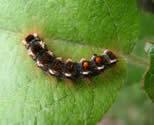Browntail Moth

2024 Browntail Moth Spraying Program Update
The infestation of browntail moth continues throughout parts of Maine. Fortunately, in the past few years, Falmouth has seen a reduction in nests and levels of infestation. In 2020, the Town of Falmouth conducted a spraying program to target areas in the public right-of-way that were deemed to be high risk. While not fully eradicating browntail moth, the spraying program worked to preserve the health of the street trees and to minimize the public health effects of this infestation.
Annual assessments continue to provide data on the severity of the infestation in our community. In 2021, 2022, and 2023, an assessment of browntail moth nests along all public ways in Falmouth found that no areas in Falmouth met the moderate criteria of risk and found no nests at all along the majority of the community's public roadways. Based on these assessments, the Town did not conduct spraying programs for those years. The Town contracted with Davey Tree Experts for this year’s assessment. The purpose of this assessment is to scout for browntail moth nests along all public ways within 15 to 20 feet of public roads and Town-owned property and parks to identify high risk areas that should be treated for possible control in May of 2024. Threshold levels used are approximately 8 to 10 nests per tree, or areas where there are multiple trees with six or more nests along or in a public way. The intent of the assessment is not to identify every tree within the Town of Falmouth public ways with nests, but to identify high risk areas using the above-mentioned thresholds. The completed assessment for the 2024 season found NO areas that meet the ‘moderate’ criteria with much of the community having no nests at all. Based on this assessment the Town will not proceed with a Browntail Moth Control Program this year. Read the assessment here.
As these assessments are intended to identify high risk areas using the above-described thresholds, the findings from this assessment does not indicate that browntail moth has been eradicated in Falmouth. It is likely that there will be nests in some trees. Residents are advised to assess their own properties for nests during the winter months. The best means of preventing a browntail moth infestation on your property is to clip and destroy overwintering webs between October and mid-April. It is also best practice to treat trees before leaves have filled in, generally by the end of May or the first week in June. Residents with trees on their property that they want treated will need to hire a qualified contractor to do so. A list of licensed pesticide applicators willing to treat browntail moth is available here: https://www.maine.gov/dacf/mfs/forest_health/documents/pesticide_applicators_bm_hwa_others.pdf
Residents are also advised that the poisonous hairs responsible for the rash that accompanies exposure to browntail moth can remain in the environment and toxic for up to three years after an infestation. Therefore, there is still a possibility of exposure this year.
For more information, see the resources below, call (207) 699-5329, or email jbaxter@falmouthme.org.
Browntail Moth Assessment for Falmouth, Maine February 2024
Browntail Moth Assessment for Falmouth, Maine February 2023
Browntail Moth Assessment for Falmouth, Maine February 2022
Resources for more information
Tools and Tips for Helping To Knock Out More Browntail Moths
Maine Forest Service Browntail Moth Information Page
Maine CDC Browntail Moth Fact Sheet
Maine DACF Browntail Moth brochure
Websites for more information on Browntail Moths:
Maine Forest Service: http://www.maine.gov/dacf/mfs/forest_health/insects/browntail_moth.htm
State of Maine "Got Pests" site: http://www.maine.gov/dacf/php/gotpests/bugs/browntail-moth.htm
Maine CDC: http://www.maine.gov/dhhs/mecdc/infectious-disease/epi/vector-borne/browntail-moth/index.shtml

